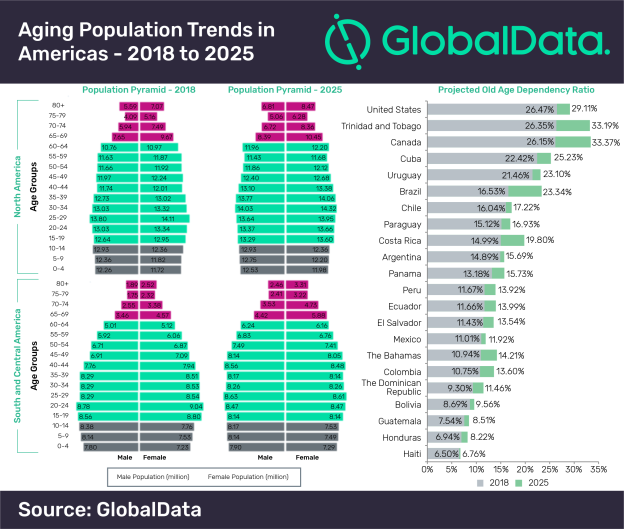
Increasing life expectancy, decreasing mortality rates and low birth rates in cities in the Americas has led to a rise in the elderly population (aged 65 and over). Against this backdrop, 116 out of 710 metropolitan cities from the American region will have more than 20% of the population in the age band of 65 years and over by 2025, according to GlobalData, a leading data and analytics company.
Rapidly aging population to transform economic and social landscape of cities
Cities in North America are grappling with aging issues with 141 cities in the US and Canada projected to have an old age dependency ratio (which measures the number of elderly people as a share of those of working age (aged between 15 and 64)), of more than 30% by 2025. Furthermore, cities in Canada had a higher elderly population than children in 2018 and the elderly population in US cities is expected to outnumber the young age population in the next two decades.
Relatively young population in cities in South and Central America compared to counterparts in North America
The population in cities in South and Central America is relatively young compared to their counterparts in North America. However, aging is faster in South and Central American cities compared to North American cities. The combined elderly population in South and Central America is expected to grow by 33.5% compared to 14.9% in cities in North America between 2018 and 2025, mainly due to an increase in life expectancy which has increased by 22 years in the last 50 years. The population of cities in most of the South and Central American cities is currently dominated by the working age population, who account for 68.6% of the population. However, the region faces the prospect of rapid aging due to a decrease in fertility rate.

Impending financial burden from aging population poses fiscal challenge
Aditi Dutta Chowdhury, Economic Research Analyst at GlobalData, comments: “Low birth rates and an increasing old age population will affect social insurance, public pension and health care systems thereby impairing the existing social support system and ultimately leading to long-term fiscal gap. High incidence of the informal sector in South and Central American economy, low labor force participation among women and high coverage of minimum contributory pensions and the health insurance system might affect the fiscal sustainability of the economy in future.”
According to IMF, public pension expenditure on average accounted for 3.7% of the total GDP in South and Central American countries in 2015, with the highest share of 11.2% in Brazil. According to OECD, the share for Canada and the US was 5.5% and 4.9% during 2013-15.
Health expenditure is likely to grow significantly due to increasing prevalence of chronic non-communicable diseases mainly among the elderly population. Total health expenditure accounted for 8.56% of overall GDP on average across South and Central American countries and 17.07% in the US, according to the World Bank.
Policy options to reduce cost burden
Parametric reforms to the public pension and health care system, coupled with promoting labor force participation of women and the elderly, will make the fiscal cost manageable.
Aditi concludes: “Pension reforms across the countries will depend on the individual country’s current system but higher retirement age was the key recommendation in most countries. However, increase in the retirement age should be accompanied by an improved disability system to protect the vulnerable workforce, who might not prolong their career due to poor health. Also, the reduction in benefits relative to wage, increased contribution to social security system and formalization of employment are additional recommendations for the sustainability of the pension system.”
- The information is based on GlobalData’s City Economics Database
About GlobalData
4,000 of the world’s largest companies, including over 70% of FTSE 100 and 60% of Fortune 100 companies, make timelier and better business decisions thanks to GlobalData’s unique data, expert analysis and innovative solutions, all in one platform. GlobalData’s mission is to help our clients decode the future to be more successful and innovative across a range of industries, including the healthcare, consumer, retail, financial, technology and professional services sectors.
As part of macroeconomic offerings for cities, GlobalData provides comprehensive data on over 3,000 cities, including major metropolitan areas covering 150 countries. The database covers over 300 indicators for each city across five essential indicator themes – demographic, economic, employment, income and expenditure data.
Long-term historical data is sourced from a number of national statistical and international institutions, with forecasts provided by its team of highly experienced economists.
This is an article provided by our partners network. It might not necessarily reflect the views or opinions of our editorial team and management.
Contributed content

Founder Dinis Guarda
IntelligentHQ Your New Business Network.
IntelligentHQ is a Business network and an expert source for finance, capital markets and intelligence for thousands of global business professionals, startups, and companies.
We exist at the point of intersection between technology, social media, finance and innovation.
IntelligentHQ leverages innovation and scale of social digital technology, analytics, news, and distribution to create an unparalleled, full digital medium and social business networks spectrum.
IntelligentHQ is working hard, to become a trusted, and indispensable source of business news and analytics, within financial services and its associated supply chains and ecosystems










